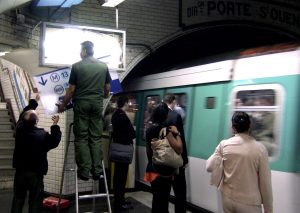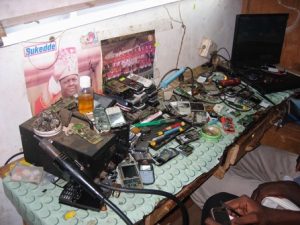Jérôme Denis arrived at the CSI in May. Part of his investigations concerns the – often-invisible – work that is being done at an earlier stage of the circulation and dissemination of data, in various areas (administrations, banks, city services…). Over the last few years, along with David Pontille, he has also developed a research interest around maintenance and repair activities.
He co-runs, with David Pontille and Didier Torny, Scriptopolis, a blog dedicated to the ordinary writing practices
The emergence of the Maintenance & Repair Studies
It was during an investigation on the Paris subway wayfinding system that David Pontille and I understood the importance of investigating a little known facet of design and innovation: the maintenance work on infrastructures and objects. At first, our study  focused on the implementation of a new wayfinding system in the corridors of the subway, and on the role of its unprecedented standardization in the ordering of transport spaces. As we were accompanying the maintenance teams during their interventions, we discovered a much less stabilized world than we thought: from day to day, the supervision and repair operations ensure the sturdiness, the sustainability and the efficiency of the signs network intended to guide the travelers.
focused on the implementation of a new wayfinding system in the corridors of the subway, and on the role of its unprecedented standardization in the ordering of transport spaces. As we were accompanying the maintenance teams during their interventions, we discovered a much less stabilized world than we thought: from day to day, the supervision and repair operations ensure the sturdiness, the sustainability and the efficiency of the signs network intended to guide the travelers.
As a result of this first experience, we turned to the more general issues raised by repair and maintenance, an under-researched area in social sciences. Over the years, we met other researchers from the United States and Europe who shared our interest, up to the point that a research network gradually took shape in what could be termed Maintenance and Repair Studies.
Investigating maintenance and repair activities is a gesture that has multiple, both theoretical and political, implications.
Rethinking innovation
The main interest of this research subject – the most obvious one – is that it requires an off-centered approach to innovation, away from the most conventional discourses that hold a very narrow view of technologies and of the actors who accompany their invention and their success. This is a long-standing gesture in Science and Technological Studies: consistently describing innovations as closely as possible to the always uncertain circumstances of their trajectories, and refusing intrinsic qualities or external social dimensions to be used backwards as explanations for the success of technologies, which, over the course of their history, were transforming at the same time as their potential users were being configured. As stated by the historian David Edgerton, considering maintenance allows to move from a hyper-simplified history focusing on a small number of moments and actors, to a complex one in which technologies do not only emerge at the very moment of their invention, but are also ceaselessly maintained, repaired, and sometimes even transformed. Largely invisible, and even denigrated, these operations are performed by women and men who do not leave their mark in the official reports, although their role is essential to the very conditions of existence of these technologies. Furthermore, maintenance and innovation are far from being opposite matters. They are continuously intertwined, certain repair or restoration operations providing opportunities for discoveries, or even for radical inventions.
Putting in perspective the breakdown and the stability
In the same vein, the careful observation of maintenance and repair activities, in particular of occupations dedicated to these activities, invites us to reexamine the way the stability of social order has been considered in social sciences. Notably, repair and maintenance invite to rethinking the very ideas of breakdown or crisis. Science and Technology Studies allowed to delinearize the description of the trajectories of innovations by insisting on the moments of stalling. In this regard, breakdown, accident or controversy were frequently used as opportunities to foreground the hybrid components of sociotechnical agencements that, in mundane situations, take the form of “black boxes”  that are not easy to grasp. Even though this posture has been extremely rich, it has however been challenged by the inquiries on repair and maintenance. In the maintainers’ eyes and hands, the opposition between a breakdown and a normal situation, or between crisis and routine, is indeed not so relevant. Taking the maintenance and repair work seriously invites to re-specify not only the sociomaterial order, which is obviously constantly maintained by a series of preventive and curative operations, but also to relativize the idea of breakdown. In certain configurations, maintenance and repair are thought as means to address some failures spotted by specialists so that they never become noticeable to users. That is what we were able to observe in the RATP wayfinding system. In other cases, on the contrary, users do their upmost to restore objects considered as definitively broken. It is what Lara Houston or Steve Jackson and his colleagues observed for example in Uganda and in Bangladesh, but also what Daniela Rosner studied in “repair cafés” in the United States and in Europe.
that are not easy to grasp. Even though this posture has been extremely rich, it has however been challenged by the inquiries on repair and maintenance. In the maintainers’ eyes and hands, the opposition between a breakdown and a normal situation, or between crisis and routine, is indeed not so relevant. Taking the maintenance and repair work seriously invites to re-specify not only the sociomaterial order, which is obviously constantly maintained by a series of preventive and curative operations, but also to relativize the idea of breakdown. In certain configurations, maintenance and repair are thought as means to address some failures spotted by specialists so that they never become noticeable to users. That is what we were able to observe in the RATP wayfinding system. In other cases, on the contrary, users do their upmost to restore objects considered as definitively broken. It is what Lara Houston or Steve Jackson and his colleagues observed for example in Uganda and in Bangladesh, but also what Daniela Rosner studied in “repair cafés” in the United States and in Europe.
Paying attention to material fragility
Becoming familiar with the actual maintenance and repair operations, not only with the skills of those who carry them out, but also with the uncertainties and the difficulties they meet, also allows to shift the perspective in which most social scientists view the role of objects our world is made of, and more generally their view of the issue of materiality. In most cases, the notion of materiality is used in sociology, organization studies or history as a means to insist on the sturdiness and the tangibility of a certain reality “that resists”. In the vein of Giddens’ works, taking the material part of the social into account would in this perspective mean recognizing how certain social configurations stabilized within artifacts both constrain and sustain a large part of our world. Without dismissing the interest of such a perspective, maintenance and repair studies encourage the consideration of quite a different, somehow inverted aspect of materiality, since they confront directly the fragility of objects and the material vulnerability of the world. The attention paid to this fragility broadens the horizon of research and allows to envisage the place of objects in the constitution of society in a different perspective, confirming the importance of material explorations in social sciences, but nipping any unspoken inclination for technical determinism in the bud.
Repair policies
Finally, addressing the issue of maintenance and repair provides an opportunity to tackle head-on the political foundations of a world revolving entirely around the economy of innovation, where the sole prospect of benefiting from technologies and ceaselessly renewed services functioning perfectly 24 hours a day seems to matter. By documenting the moments of repair and maintenance, we discover this world behind-the-scenes. Close sidelines, populated with invisible workers who do their utmost to “keep the machinery running” by supervising, strengthening, adapting, cleaning, mending, restoring objects and infrastructures, and ensure comfortable continuity of their use; or distant sidelines, relegated to poor countries where uncountable operations are invented in order to revive  and extend the use of technologies that come mostly from rich countries trash. For some time, in addition to these hardly or not at all visible spaces, real explicit struggles occur, involving users’ organizations claiming a right to repair, refusing the logic of planned obsolescence that is at the center of the innovation dynamic.
and extend the use of technologies that come mostly from rich countries trash. For some time, in addition to these hardly or not at all visible spaces, real explicit struggles occur, involving users’ organizations claiming a right to repair, refusing the logic of planned obsolescence that is at the center of the innovation dynamic.
From maintenance to care
Maintenance and repair studies are thus carried on in the vein of a research that, over the last years, invites to question care practices in the broadest sense of the term. Beyond innovation and innovators, what can be learned from those who take care of the world they live in? How can we think both care for people and care for things? How can we take the vulnerability of our world into account, leaving aside innovation-centered normativity Hopefully, asking these questions will give us the basis to develop what Maria Puig de la Bellacasa calls an “ethos of care” within the Science and Technology Studies.
For further reading, see:
Denis, J. & Pontille, D. 2014. « Maintenance work and the performativity of urban inscriptions: the case of Paris subway signs », Environment and Planning D: Society and Space 32(3), pp. 404-416. (preprint)
Denis, J. & Pontille, D. 2015. « Material Ordering and the Care of Things », Science, Technology, & Human Values 40(3), pp. 338-367. (preprint)
Denis, J. & Pontille, D. 2015. « The dance of maintenance and the dynamics of urban assemblages », i3 Working Papers Series, 15-CSI-03.
Photo #1: Copyright: J. Denis and D. Pontille, Changing of a wayfinding sign in the Paris metro, July 2007.
Photo #2: Copyright: Lara Houston, Untitled, Repair shop, Kampala 2014.
Photo #3: Ikiwaner, Repair, 5 May 2008 Wikimedia Commons (CC Attribution-Share Alike 3.0 Unported)

